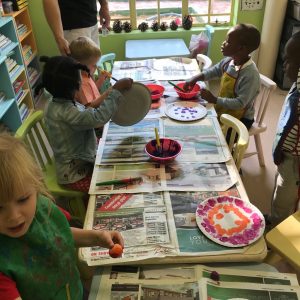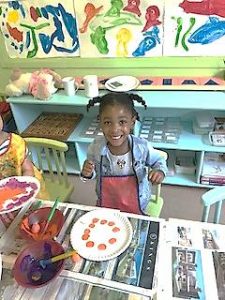Incorporate art-making into your child’s playtime at home.
 Make an art-zone if you want to isolate the mess.
Make an art-zone if you want to isolate the mess.
Tape down paper for them to draw on and spill on, and make a smock out of old clothes.
Taping paper on a table can help a small child focus on the motion of drawing, without having to hold down and adjust the drawing paper.
Children will begin their drawing by scribbling.
Around 2 years of age, the scribbles will become more controlled and repetitive, and children may begin to grip crayons and markers between their thumb and pointer finger for more control.
- Offer a variety of art materials at this age. (Thick crayons, thin crayons, pencil crayons, stencils etc.)
- Don’t focus only on drawing with tools: children can draw by tracing pictures in sand, or shaping clay or play dough. Buy washable paints, nontoxic clay, chalk, child-safe scissors, and many kinds of paper, and store in an easy to access spot.
- Don’t teach.Children develop basic motor skills with every scribble. They also develop creativity, invention, and self-expression.
- Talk with them about their art, but do not attempt to teach.
- Avoid the impulse to correct.
- Small children may paint purple grass, floating people, and babies the size of houses. If you correct them you will damage their self-confidence and interrupt their natural learning progress.
- Ask open-ended questions.Avoid asking “what is it?” when presented with a drawing. Instead, ask “A child this young needs no instructions, only appreciation. Sit with children when they draw, talk can you tell me about your drawing?”
- If a child is excited to talk about their drawing, ask more questions. A child may begin to add more details when you ask questions. When a child is drawing representational work, they will often imagine a story that goes with the work. Asking them to tell you more details of their story will encourage them to draw more details.
- If you ask “What does the girl smell,” for example, they are more likely to add a nose. If you ask “Is the dog lonely at night?” they may draw more animals. This kind of exchange encourages imagination, story-telling abilities, and drawing skills.
- Make art part of emotional processing.If a child is experiencing a strong emotion, offer them paper and markers, or some clay. Art can help children process intense emotions that may be too complex for them to put in words. Giving a child a creative activity over which they have sovereignty can help them gain a sense of control.
- Display and save their drawings.Putting children’s art up is a way of letting them know their work is interesting and important. Rather than praising every individual drawing, display it. You do not have to put up every piece of art: ask each child what they would like displayed, or create a rotating “gallery” that changes weekly or monthly. Keep a portfolio of each child’s drawings so they can observe their process.
- It is more important that a child’s practice is affirmed than that their art products are displayed. Displaying final products is no replacement for encouraging the development of their drawing.
- Focus on one medium at a time.Offer children the chance to practice with different media. Children between 4-8 yrs. old may be open to drawing with pencils, which will allow them to focus on shading and contour. Show children different materials and allow them to experiment. Suggest phases: First we will draw with a pencil, then with watercolours.




